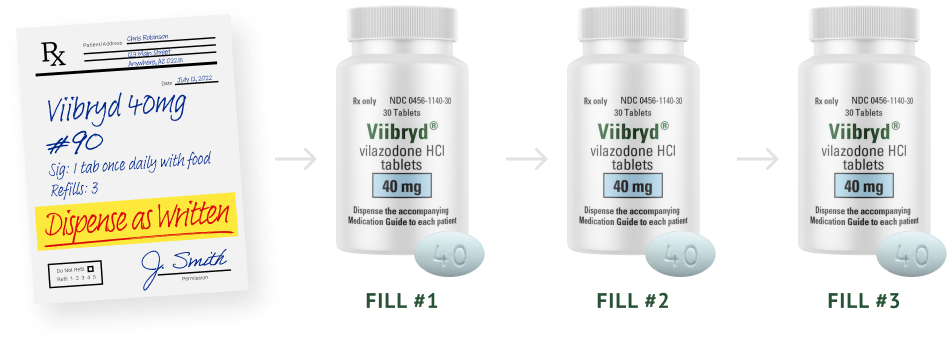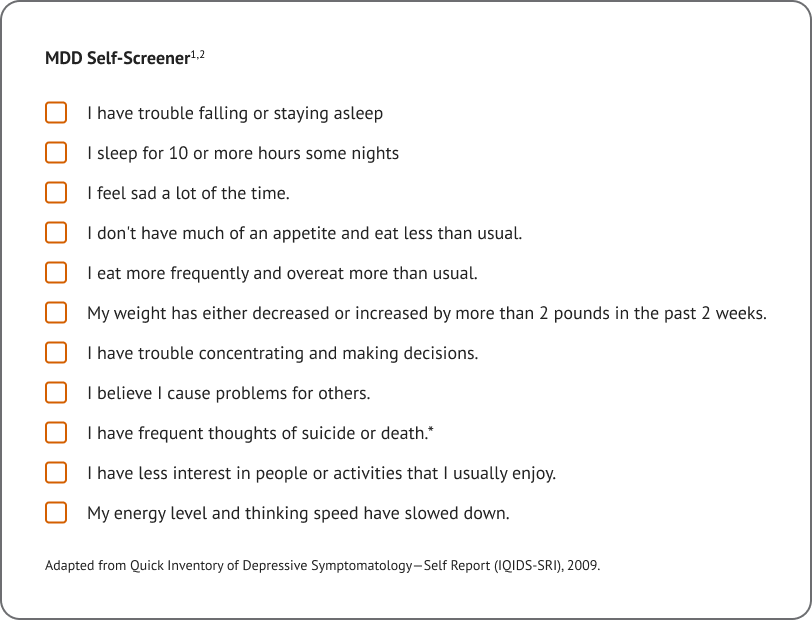*Eligible patients may pay as little as $15 per 30- or 90-day VIIBRYD prescription fill. Check with your pharmacist for your out- of-pocket cost. Maximum savings limit applies; patient out-of-pocket expense may vary. Patients residing in or receiving treatments in certain states may not be eligible. Offer not valid for patients enrolled in Medicare, Medicaid, or other federal or state healthcare programs. See back of card for full terms and conditions or click here.
3 THINGS TO KNOW IF YOU’VE BEEN
PRESCRIBED
BRAND-NAME VIIBRYD

PROVEN EFFECTIVE
In four clinical studies, the effect of Viibryd was measured by the total score* on a scale that evaluated symptoms of depression, including:
- Apparent or reported sadness
- Inner tension
- Reduced sleep
- Reduced appetite
- Difficulty concentrating
- Difficulty performing daily activities
- Reduced interest in daily activities
- Negative thoughts
- Thoughts of suicide
*Individual symptoms were not assessed independently.
Patients who took Viibryd in these studies experienced significant improvement in their depressive symptoms compared with those who took a placebo ("sugar pill”).
There can be side effects for people who take Viibryd. To learn more, including answers to frequently asked questions about taking Viibryd, see Medication Guide.

PATIENT SAVINGS PROGRAM
With a Viibryd Savings Card, eligible* patients may pay as little as $15 for a 90-day or 30-day prescription—that’s as little as $5 a month, or 17¢ per day, with a 90-day prescription.
According to the Association for Accessible Medicine, the average copay for a generic prescription in the U.S. is roughly $7.
Ask your doctor to consider whether a 90-day prescription of brand-name Viibryd is right for you. It could mean fewer trips to the pharmacy and additional savings on your out-of-pocket costs.
*This offer is available to patients with commercial insurance coverage and a valid Viibryd prescription. Offer not valid for patients enrolled in Medicare, Medicaid, or other federal or state healthcare programs. Please see back of savings card or click here for Program Terms, Conditions, and Eligibility Criteria.

CONFIDENCE WITH EVERY REFILL
When you get brand-name Viibryd, you know you’ll receive the same oval tablet from the same manufacturer with every refill at the pharmacy.
Did you know? Vilazodone (the active ingredient in Viibryd) may come in different shapes, sizes, and colors, so ask for branded Viibryd.
SAME PILL
EVERY REFILL
Ask your doctor for a 90-day prescription.

3 TIPS TO HELP ENSURE YOU RECEIVE YOUR PRESCRIPTION FOR BRAND-NAME VIIBRYD.
If your doctor prefers for you to stay on branded Viibryd, here are 3 steps you can take to make sure you get branded Viibryd at the pharmacy:

Ask your doctor to note his or her preference by adding “dispense as written” (or your state’s legal language) to a brand-name Viibryd prescription.

Let your pharmacist or mail-order service know that your doctor prefers brand-name Viibryd. Remember, for commercially insured patients, the Viibryd Savings Card may help eligible patients save on their out-of-pocket costs.

Check your pill. Before leaving the pharmacy, or as soon as your prescription arrives, check the tablet to make sure it says “Viibryd” on it. Viibryd tablets are oval and come in red (10mg), orange (20mg) and light blue (40mg). If you don’t receive brand-name Viibryd, let your pharmacist know you want what your doctor prefers.

TAKING VIIBRYD

Take Viibryd exactly as prescribed. Your doctor may need to change the dose of Viibryd until it is the right dose for you.

Take Viibryd once daily with food as Viibryd may not work as well if taken on an empty stomach.

Try to take Viibryd at the same time every day to help you remember to take it.

If you miss a dose of Viibryd, take the missed dose as soon as you remember. If it is almost time for the next dose, skip the missed dose and take your next dose at the regular time. Do not take 2 doses of Viibryd at the same time.

Keep taking Viibryd as directed by your healthcare provider. Response to treatment may vary, so you may not feel the effect of Viibryd for several weeks. Do not stop taking Viibryd without speaking to your healthcare provider, even if you start feeling better.

Talk to your doctor before you stop taking Viibryd. If you have questions about side effects, he or she may have helpful information. Stopping Viibryd suddenly may cause serious symptoms, including anxiety, irritability, high or low mood, feeling restless or sleepy, headache, sweating, nausea, dizziness, tremor, electric shock-like sensations, and confusion.
VIIBRYD–A BRAND NAME YOU CAN TRUST
10+YEARS ON THE MARKET
4CLINICAL STUDIES
>150kDOCTORS HAVE
PRESCRIBED VIIBRYD

QUALITY AND SAFETY
TOOLS & RESOURCES
Depression Self-Screener
Sharing the results of this screener with your healthcare professional can help them to further evaluate your symptoms to determine if you have depression and to develop a treatment plan for you.
Print Self-ScreenerDoctor Discussion Guide
Talking to your doctor about depression doesn’t have to be hard. Here are some simple tips to help you prepare for that conversation.
Print guideViibryd Savings Program
With a Viibryd Savings Card, eligible* patients may pay as little as $15 for a 90-day or 30-day prescription—that’s as little as $5 a month, or 17¢ per day, with a 90-day prescription.
*This offer is available to patients with commercial insurance coverage and a valid Viibryd prescription. Offer not valid for patients enrolled in Medicare, Medicaid, or other federal or state healthcare programs. Please see back of savings card or click here for Program Terms, Conditions, and Eligibility Criteria.
Access offerMore Information
- Visit these resources to learn more about depression and how to manage it:
- American Psychiatric Association psychiatry.org
- National Alliance on Mental Illness nami.org
- Depression and Bipolar Support Alliance dbsalliance.org
Please note: These resources are cited for information purposes only and do not imply recommendation or endorsement by AbbVie.
VIIBRYD® (vilazodone HCI) is a prescription medicine indicated for the treatment of major depressive disorder (MDD) in adults.
VIIBRYD and other antidepressants may increase suicidal thoughts or actions in some people 24 years of age and younger, especially within the first few months of treatment or when the dose is changed. VIIBRYD is not for use in children.
Depression or other serious mental illnesses are the most important causes of suicidal thoughts or actions. Some people, including those with (or with a family history of) depression, bipolar illness, or a history of suicidal thoughts or actions may have a higher risk of suicidal thoughts or actions. Pay close attention to and call your healthcare provider right away to report any new or sudden changes in mood, behavior, thoughts or feelings.
Call your healthcare provider right away if you have any of these symptoms, especially if they are new, worse, or worry you:
- Attempts to commit suicide; acting on dangerous impulses; acting aggressive or violent; thoughts about suicide or dying; new or worse depression, new or worse anxiety; panic attacks; feeling agitated or restless; new or worse irritability; trouble sleeping; an extreme increase in activity or talking (mania); or other unusual changes in behavior or mood
Do not take VIIBRYD if you take a monoamine oxidase inhibitor (MAOI), have taken or will take an MAOI within 14 days of taking VIIBRYD, or are being treated with the antibiotic linezolid or intravenous methylene blue.
Serotonin Syndrome: A potentially life-threatening problem that can happen when VIIBRYD is taken with certain other medicines. Stop taking VIIBRYD and call your healthcare provider or go to the nearest emergency room right away if you have any of the following: agitation; hallucinations; confusion, coma; fast heart beat; blood pressure changes; dizziness; sweating; flushing; high body temperature; tremors, stiff muscles, or muscle twitching; loss of coordination; seizures; nausea, vomiting or diarrhea
Increased chance of bleeding: Taking VIIBRYD with aspirin, non-steroidal anti-inflammatory drugs (NSAIDs), warfarin, or blood thinners may add to this risk. Tell your healthcare provider right away about unusual bleeding or bruising
Manic episodes: Symptoms may include greatly increased energy; severe trouble sleeping; racing thoughts; reckless behavior; unusually grand ideas; excessive happiness or irritability; talking more or faster than usual
Discontinuation symptoms: Do not suddenly stop VIIBRYD without first talking to your healthcare provider. Stopping VIIBRYD suddenly may cause serious side effects including: nausea; sweating; changes in mood; headache; irritability and agitation; tiredness; dizziness; problems sleeping; electric shock sensation; hypomania; anxiety; ringing in your ears; confusion; seizures
Seizures or convulsions
Glaucoma (angle-closure glaucoma): VIIBRYD may cause an eye problem called angle-closure glaucoma. Call your healthcare provider if you have changes in your vision or eye pain
Low salt (sodium) levels in the blood: May be serious and may cause death. Elderly people may be at greater risk for this. Symptoms may include headache; difficulty concentrating; memory changes; confusion; weakness and unsteadiness which can lead to falls
In severe or more sudden cases, symptoms include hallucinations; fainting; seizures; coma; respiratory arrest; death
Sexual problems: Taking VIIBRYD may cause sexual problems. Talk to your healthcare provider if you develop any changes in your sexual function or if you have any questions or concerns about sexual problems during treatment
-
Tell your healthcare provider about any medical conditions
or if you:
- Have or have a family history of suicide, depression, bipolar disorder, mania or hypomania
- Have or had bleeding problems
- Have or had seizures or convulsions
- Have high pressure in the eye (glaucoma)
- Have low salt (sodium) levels in your blood
- Drink alcohol
- Are pregnant or plan to become pregnant. Taking VIIBRYD late in pregnancy may lead to an increased risk of certain problems in your newborn. Talk to your healthcare provider about the risks to your baby if you take VIIBRYD during pregnancy. If you become pregnant during treatment with VIIBRYD, talk to your healthcare provider about registering with the National Pregnancy Registry for Antidepressants at 1‑844‑405‑6185
- Are breastfeeding or plan to breastfeed. It is not known if VIIBRYD passes into breast milk. Talk to your healthcare provider about the best way to feed your baby during treatment with VIIBRYD
-
Tell your healthcare provider about all prescription and
over-the-counter medications, vitamins, and herbal
supplements you are taking or plan to take,
especially:
- MAOIs; triptans (medicines used to treat migraines); tricyclic antidepressants; fentanyl; lithium; tramadol; tryptophan; buspirone; amphetamines; St. John’s Wort; medicines that can affect blood clotting such as aspirin, NSAIDs, and warfarin; diuretics; medicines used to treat mood, anxiety, psychotic, or thought disorders, including selective serotonin reuptake inhibitors (SSRIs) and serotonin norepinephrine reuptake inhibitors (SNRIs)
VIIBRYD may affect the way other medicines work, and other medicines may affect how VIIBRYD works. Do not start or stop any medicines while taking VIIBRYD without talking to your healthcare provider.
- Do not drive, operate heavy machinery, or engage in other dangerous activities until you know how VIIBRYD affects you. VIIBRYD can cause sleepiness or may affect your ability to make decisions, think clearly, or react quickly. Avoid drinking alcohol while taking VIIBRYD.
- The most common side effects of VIIBRYD include diarrhea, nausea or vomiting, and trouble sleeping. These are not all the possible side effects of VIIBRYD.
Call your doctor for medical advice about side effects.
Please also see Medication Guide within the full Prescribing Information.











